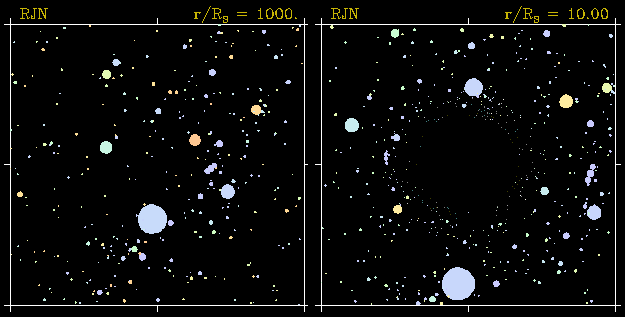
|
Credit & Copyright: Robert Nemiroff
(MTU)
Explanation:
What would you see if you went right up to a
black hole?
Above are two computer generated images
highlighting how strange things would look.
On the left is a normal star field containing the
constellation Orion.
Notice the three stars of nearly equal brightness that make up
Orion's Belt.
On the right is the same star field but this time with a
black hole superposed in the center of the frame.
The
black hole has such strong
gravity that light is noticeably bent towards it -
causing some very unusual
visual distortions.
In the distorted frame, every star in the normal frame
has at least two bright images - one on each side of the
black hole.
In fact, near the
black hole, you can see the whole sky -
light from every direction is
bent around and comes back to you.
Black holes are thought to be the densest state of matter,
and there is indirect evidence for their presence in
stellar binary systems
and the centers of
globular clusters,
galaxies, and
quasars.
|
January February March April May June July August September October November December |
| ||||||||||||||||||||||||||||||||||||||||||||||||
NASA Web Site Statements, Warnings, and Disclaimers
NASA Official: Jay Norris. Specific rights apply.
A service of: LHEA at NASA / GSFC
& Michigan Tech. U.
Based on Astronomy Picture
Of the Day
Publications with keywords: black hole - gravitational lens
Publications with words: black hole - gravitational lens
See also:
- APOD: 2025 December 3 Á Visualization: Near a Black Hole and Disk
- APOD: 2025 September 24 Á GW250114: Rotating Black Holes Collide
- APOD: 2025 May 9 Á IXPE Explores a Black Hole Jet
- APOD: 2025 May 6 Á The Doubly Warped World of Binary Black Holes
- APOD: 2025 May 4 Á Spin up of a Supermassive Black Hole
- APOD: 2025 April 21 Á Galaxy Lenses Galaxy from Webb
- APOD: 2024 November 24 Á Journey to the Center of the Galaxy
